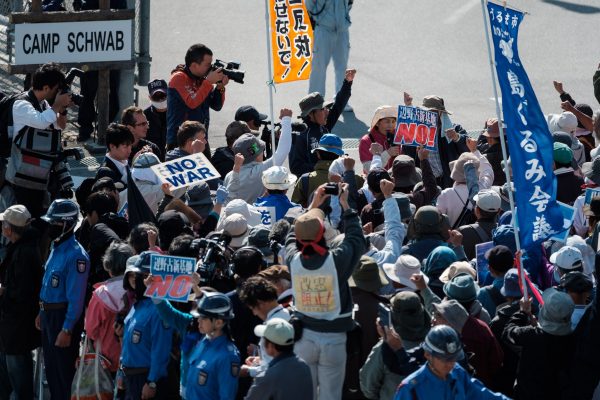Two notable developments related to the Futenma relocation plan took place in the second half of 2018. First, Denny Tamaki became the prefecture’s new governor after a convincing victory in the 30 September gubernatorial election. Tamaki maintains the same stance against the relocation plan as former governor Takeshi Onaga, who passed away on 8 August 2018. Second, Okinawa scheduled a prefectural referendum on the construction of a Futenma replacement facility in Henoko, along the northeastern coast of the main island.
What Japan and the United States should understand — but what is often misinterpreted — is that the majority of Okinawans do not disapprove of the US presence per se, but are simply asking for the Futenma Air Station to cease operations. The base is located in the middle of a residential area and a series of aircraft accidents have caused anxiety among citizens. Many also doubt Tokyo’s claim that relocation of the station will ease the island’s base-hosting burdens, and worry that it will merely hand off the same impact to residents in the northern part of the island.
The situation in Okinawa since 2015 is reminiscent of that of 1995–96. One case of deja-vu is Okinawa’s confrontation with Tokyo. In the 1990s, former governor Masahide Ota rejected a proxy signature for leasing private and municipal land to the US military, challenging Tokyo to reconsider the heavy burden of the US presence in Okinawa. The refusal led to a court battle between Okinawa and Tokyo, which Okinawa lost.
In 2015, then governor Onaga cancelled permission for land reclamation in Oura Bay that his predecessor had issued for the construction of a Futenma replacement facility in Henoko. The central government filed a suit against Onaga and the Supreme Court judged his act to be illegal. After Onaga’s sudden passing, Okinawa again withdrew approval of the land reclamation on 31 August 2018 as a last legal and administrative resort. Construction was suspended, but re-started in mid-December despite local resistance.
The second similarity is the prefectural referendum. In September 1996, a prefectural referendum was held in Okinawa in an attempt to influence the political decision-making process. The referendum confirmed that 89 per cent of voters were in favour of revising the US-Japan Status of Forces Agreement and reducing the number of US military bases in Okinawa. In October 2018, the Okinawa prefectural assembly approved an ordinance for another referendum, and Governor Tamaki announced that it would be held on 24 February 2019.
The purpose of the referendum is to plainly ask whether Okinawan voters agree or disagree with the plan to relocation Futenma to Henoko. While some argue that the past elections, which saw Onaga and Tamaki win on an anti-base platform, have already presented the will of the people, most believe it is important to address the singular issue of the Futenma relocation plan. The people of Okinawa have accumulated knowledge and experience over the past two decades, and prevailing ideas regarding US military bases in Okinawa have changed since 1996.
First, there is a heightened understanding that the US Marine Corps could function as an equally if not more effective deterrent against regional aggression if stationed in locations other than Okinawa. Journalists and scholars have revealed that US Marines in Okinawa are deployed from a ship based in Sasebo, which somewhat discredits arguments about Marines’ readiness and Okinawa’s strategic location. Historical research has also disclosed that Marines were not originally stationed in Okinawa but redeployed from mainland Japan during the 1945–72 US occupation of Okinawa. Finally, former Japanese and US officials who were involved in the base negotiations have confessed that Henoko is not necessarily the only suitable option for a Futenma replacement site.
Second, Okinawans increasingly recognise that US bases are a hindrance to the prefecture’s economy. A local government research report revealed that the return of some major US bases to Japan would bring a tremendous economic ripple effect. And this effect was realised following the return of several acres of land that were developed into offices, shopping malls and housing, leading to an increase in local economy activity, employment and tax revenue.
Okinawa’s tourism industry is in good shape but could be further expanded. In 2017, the number of tourists travelling to Okinawa rose to numbers comparable to those of Hawaii. Okinawans’ hopes of becoming less economically dependent on subsidies from Tokyo (in exchange for taking on the burden of US military presence) are reflected in the defeat Tamaki’s rival candidate, Atsushi Sakima, who was endorsed by Japan’s ruling Liberal Democratic Party.
Whatever the outcome of the referendum, the Futenma relocation project appears difficult to halt, partly because extraordinary volumes of bureaucratic and bilateral arrangements sustain the project. The ruling, progressive parties in Okinawa recognise the importance of generating an outcome significant enough to force Tokyo to give up the relocation plan. For that reason, they are aiming for high voter turnout and for over 390,000 votes against the relocation (to surpass the number of votes cast for Governor Tamaki in the September 2018 gubernatorial election).
Both Tokyo and Washington should honour Okinawa’s democratic decision. Overlooking it would risk eroding the fundamental democratic values that the bilateral alliance emphasises. Japan and the United States should use the referendum as an opportunity to convert the 20-year-old relocation plan into a more efficient and collaborative solution, further evolving the security alliance into a relationship built on long-term benefit and mutual trust.
Shino Hateruma is a PhD candidate at the Graduate School of Asia-Pacific Studies, Waseda University. She worked as a researcher at the Regional Security Policy Division, Okinawa Prefectural Government from July 2013 to March 2015.

